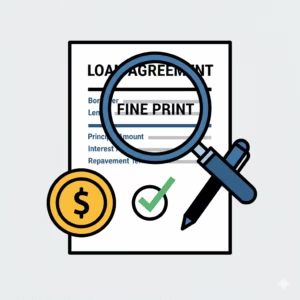When is it worth taking out a loan and when is it not?
Find out the best time for you to take out a loan

The word “debt” carries a heavy weight. For many Americans, it’s a source of stress, a four-letter word synonymous with financial trouble and sleepless nights. We’re often told that the path to wealth is to be “debt-free.”
But what if that’s not the whole story?
The truth is, debt is neither good nor bad. It’s a tool. Like any powerful tool, it can be used to build incredible wealth and opportunity, or it can be used in a way that causes serious damage. A hammer can build a house, or it can smash a window. The difference is not the tool, but the purpose for which it’s used.
Taking out a loan is a major financial decision. Knowing when a loan is a smart strategic move and when it’s a financial trap is one of the most important skills you can learn.
This comprehensive guide will break down the concept of “good debt” vs. “bad debt,” explore the scenarios where a loan can help you get ahead, and highlight the red-flag situations you must avoid.
Financial Disclaimer: This article is for informational and educational purposes only. It is not financial advice. You should always consult with a qualified financial advisor to analyze your personal situation before taking on any form of debt.
Understanding “Good Debt” vs. “Bad Debt”: A Core Concept

Before you can decide if a loan is “worth it,” you need to understand this fundamental concept. The distinction has nothing to do with the type of loan and everything to do with what you buy with it.
What is Good Debt?
Good debt is money you borrow to purchase an asset that has the potential to increase in value or generate income. In short, good debt should make you money over the long term. You are using borrowed capital (leverage) to build your net worth.
-
Classic Example: A mortgage. You borrow $300,000 to buy a house. Over 30 years, the house (the asset) will likely appreciate in value, and you are building equity with every payment. That loan is helping you build wealth.
What is Bad Debt?
Bad debt is money you borrow to purchase depreciating assets or consumables. A depreciating asset is something that loses value over time (like a car). A consumable is something that is used up (like a vacation or a meal).
-
Classic Example: A $5,000 credit card balance from a vacation. The vacation is over, the memories are fading, but the high-interest debt remains. The loan has created no lasting value; it is only a drain on your future income.
Your entire decision process should be focused on one question: “Will this loan put more money in my pocket in the future, or will it only take money out?”
When Is Taking Out a Loan a Smart Financial Move?
In these situations, a loan can be a powerful and intelligent financial tool to accelerate your goals.
1. Investing in Real Estate (Mortgages)
This is the most common and accepted form of “good debt.” Very few people can afford to buy a home in cash. A mortgage allows you to:
-
Use Leverage: You can control a large, valuable asset (a $400,000 home) with a relatively small down payment (e.g., $80,000).
-
Build Equity: A portion of every monthly payment reduces the loan principal, building your ownership stake (equity) in the home.
-
Benefit from Appreciation: Over the long term, real estate has historically appreciated, meaning your asset is growing in value.
A mortgage is a loan that helps you buy an asset that, in most cases, will significantly grow your net worth.
2. Funding Your Education (Student Loans)
This can be one of the best investments you ever make: an investment in your “human capital.” A student loan is taken out with the express purpose of increasing your future earning potential.
A degree in engineering, medicine, or finance can have a massive return on investment (ROI), potentially adding millions to your lifetime earnings.
-
The Caveat: This is only “good debt” if the cost of the loan is in line with the expected income. Taking out $200,000 in private loans for a degree with an average starting salary of $40,000 is not a good investment. You must analyze the ROI.
3. Starting or Growing a Business
Businesses run on capital. A smart business loan can be the difference between stagnation and growth.
-
Buying a new piece of equipment that triples your production.
-
Funding a marketing campaign that acquires thousands of new customers.
-
Purchasing inventory in bulk at a steep discount.
In each case, the loan should directly generate more revenue than the total cost of the loan (principal + interest). This is “using debt to make money” in its purest form.
4. Consolidating High-Interest Debt
This may seem counterintuitive—taking out a new loan to pay off old loans. But it can be a brilliant financial move.
Imagine you have $15,000 in credit card debt spread across three cards, with an average APR of 24.99%. You are drowning in interest.
You get approved for a personal loan for $15,000 at a fixed APR of 9.99% with a three-year term.
You use the new loan to pay off all three credit cards immediately. You have not reduced your total debt, but you have:
-
Slashed your interest rate by 15%.
-
Saved yourself thousands of dollars in interest charges.
-
Created a single, fixed monthly payment with a clear end date.
This type of loan is a strategic tool to get out of debt faster and cheaper.
5. Handling a True, Unavoidable Emergency
Sometimes, life happens. If you have a medical emergency or your car’s engine (which you need to get to work) blows up and you don’t have an emergency fund, a loan is a better option than letting the problem spiral (e.g., losing your job). This is a “last resort” loan, but it is justifiable.
When Is Taking Out a Loan a Financial Trap? (The Red Flags)

These are the scenarios where a loan is almost always “bad debt.” These are the traps that build financial stress and destroy wealth.
1. Funding a Depreciating Asset (Especially New Cars)
This is the most common debt trap in America. A new car loses 20-30% of its value in the first year alone.
If you take out a $40,000, 7-year loan for a new car, you are paying interest on an asset that is actively losing value every single day. Within a year, you are likely “upside down” (or “underwater”), meaning you owe more on the loan than the car is worth. This is a classic wealth-destroying move.
-
Smarter Move: Save up and buy a reliable 2-3 year old used car in cash, or with a very large down payment on a short-term (3-year) loan.
2. Paying for a Lifestyle You Can’t Afford
This category includes any loan or credit card debt used to pay for non-essential, consumable “wants.”
-
Vacations
-
A lavish wedding
-
Designer clothes, jewelry, or electronics
-
Regularly dining out or going to bars
Borrowing money for a fleeting experience is the definition of “bad debt.” You are sacrificing your future financial security for a present luxury. If you can’t afford to pay for it in cash, you can’t afford it.
3. Covering Your Regular Monthly Bills
This is a critical red flag. If you are using a personal loan, payday loan, or credit card cash advance to pay your rent, utilities, or groceries, you are not just in debt—you are in a debt spiral.
This means your monthly expenses are higher than your monthly income. A loan doesn’t fix this; it only patches the hole for 30 days while making the problem worse by adding interest and a new bill. This is a sign of a deep budget crisis that requires immediate, drastic action, not a new loan.
4. Speculative Investments or Gambling
You should never borrow money to “play the market” or gamble.
-
“I’ll take out a personal loan to buy this hot new crypto.”
-
“I’ll use a cash advance to hit the casino.”
This is not investing; it’s gambling with borrowed money. You are taking on a guaranteed cost (the loan’s interest) for a highly uncertain gain. A 10% loan to buy a stock that might go up 8% is already a losing proposition, and that’s before accounting for the risk of it going to zero.
5. “Keeping Up With the Joneses”
This is the psychological trap. You take out a loan for a boat, an RV, or a kitchen remodel you don’t really need simply because your friends, family, or neighbors have them.
This is borrowing money to finance someone else’s opinion of you. The social validation is temporary, but the debt is long-term.
The 5 Critical Questions to Ask Before You Sign for Any Loan
If you’re on the fence, run your decision through this 5-point checklist. If you can’t answer “yes” to all of them, you should probably walk away.
1. What is the True Total Cost?
Don’t just look at the monthly payment. Look at the APR (Annual Percentage Rate), which includes the interest rate plus any fees. Ask for the amortization schedule. How much total interest will you pay over the life of the loan? A $30,000 loan might cost you $38,000 by the time you’re done. Is the purchase worth $38,000?
2. Can I Comfortably Afford the Monthly Payment?
“Afford” doesn’t mean “I can just make it if I eat ramen noodles.” A responsible payment should fit easily into your budget. Lenders will often approve you for more than you should responsibly borrow. Calculate your debt-to-income (DTI) ratio. If this new loan pushes your total monthly debt payments (including mortgage, etc.) above 35-40% of your gross income, you are entering a financial danger zone.
3. What is the Purpose and its ROI?
This is the “good debt vs. bad debt” test. Be brutally honest. Is this loan for an asset or a consumable? Will it make you money, save you money (like debt consolidation), or only cost you money?
4. Are There Any Alternatives?
A loan is rarely the only option.
-
Savings: Can you simply save up for this item over the next 6-12 months and buy it with cash? (This is almost always the cheapest way).
-
0% APR Credit Card: For a smaller, planned purchase, a credit card with a 0% introductory APR offer can be an interest-free loan, if you are disciplined enough to pay it off completely before the intro period ends.
-
Sell Something: Can you sell an old car, electronics, or other items to fund the purchase?
5. What is the Worst-Case Scenario?
What happens if you lose your job or have a medical emergency in 6 months?
-
Is the loan secured? (e.g., an auto loan or home equity loan). If so, the bank can seize your car or your house.
-
Is it unsecured? (e.g., a personal loan). If you default, your credit score will be destroyed for 7+ years, and you can be sued, have your wages garnished, or be forced into bankruptcy.
Understanding Loan Types and Their Hidden Risks

Not all loans are created equal. The type of loan can dramatically change the risk involved.
-
Secured Loans (Mortgages, Auto Loans, HELOCs): These loans are “secured” by collateral (an asset). Because the bank has an asset to seize if you default, these loans have lower interest rates. The risk is higher for you in one sense: you can lose your property.
-
Unsecured Loans (Personal Loans, Credit Cards):V These are based only on your creditworthiness. There is no collateral. Because the lender is taking on more risk, they charge much higher interest rates. The risk to you is to your credit and financial future.
-
Payday Loans (AVOID AT ALL COSTS): This is a form of predatory lending, not a real financial tool. With APRs that can exceed 400%, these loans are designed to trap you in an endless cycle of debt. They are never, under any circumstances, “worth it.”
Is a Loan Right for You?
A loan is not a sign of failure. It is a powerful financial product.
A loan is worth it when it is a strategic, planned decision to purchase an asset or an opportunity that will increase your net worth. It is a bridge to a better financial position.
A loan is not worth it when it is an emotional, impulsive decision to fund a lifestyle or purchase a depreciating item. In this case, it is not a bridge; it’s an anchor, holding you back from your future.
Before you sign, look past the temporary joy of the purchase and look at the long-term cost. Is this loan building the future you want, or is it just stealing from it? The answer to that question will tell you everything you need to know.





